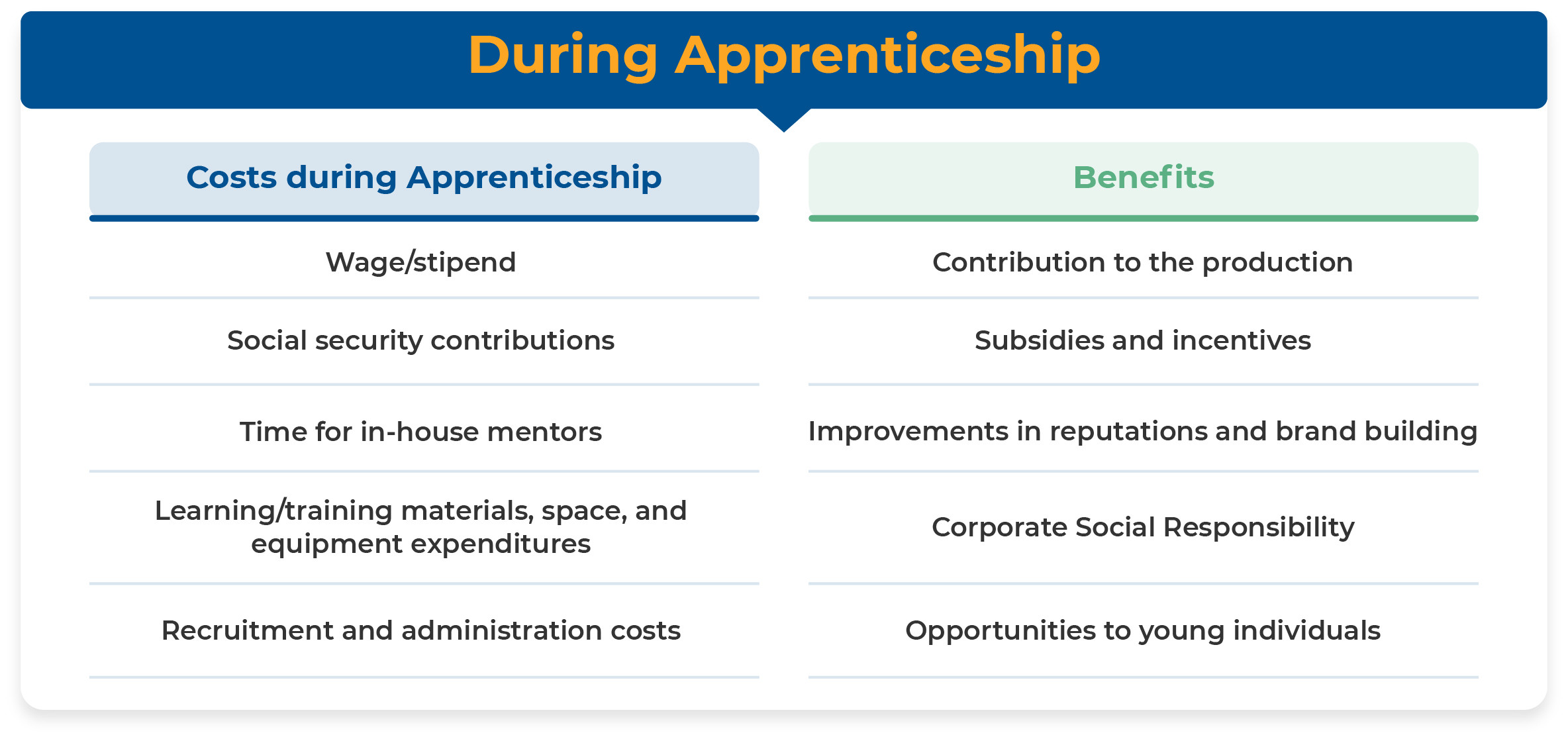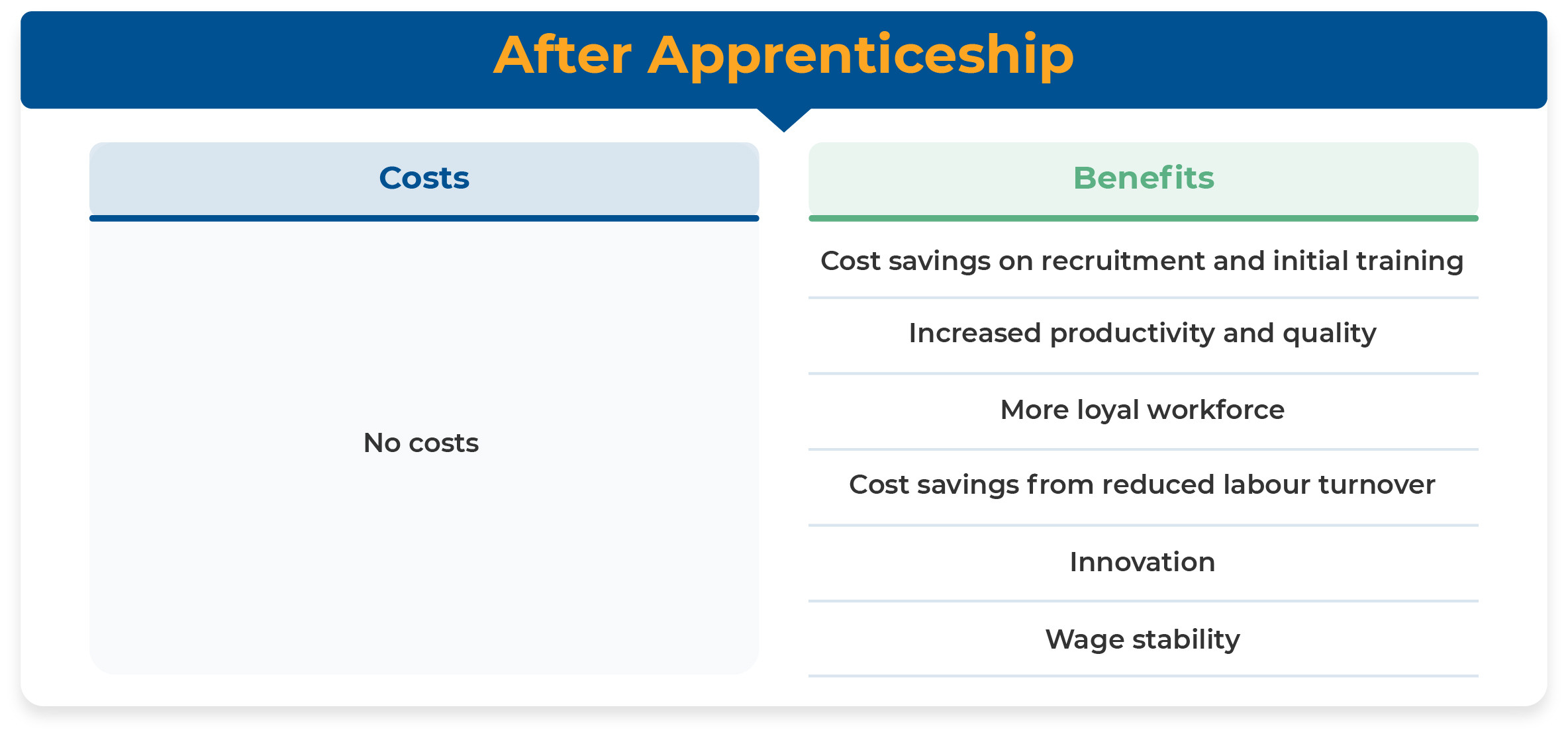Apprenticeships are increasingly popular as a workforce development strategy, providing tangible benefits to both employers and apprentices. However, like any business decision, the implementation of an apprenticeship program comes with its own set of costs and benefits.
This blog will break down these factors, offering a comprehensive cost-benefit analysis of apprenticeships for employers.
Costs for Employers during Apprenticeship
Implementing an apprenticeship program requires an upfront investment from employers. Below are the key areas where costs are incurred:
1. Wage/Stipend
Apprentices must be compensated for their work. While the wages are generally lower than those of fully qualified employees, they still represent a significant expense, especially in industries with high minimum wage standards.
2. Social Security Contributions
Employers are responsible for making social security contributions for their apprentices. These contributions might cover benefits such as health insurance.
3. Time for In-House Mentors
Mentorship is crucial to the success of an apprenticeship. Experienced employees who serve as mentors need to allocate time from their regular duties to provide guidance and training.
4. Learning/Training Materials, Space, and Equipment Expenditures
Training apprentices often requires specialized materials, tools, and equipment. Additionally, dedicated training spaces may be necessary to ensure that apprentices can learn in a conducive environment. These expenditures can add up, particularly in technical or highly specialized fields.
5. Recruitment and Administration Costs
Finding the right apprentices and managing the program involves recruitment and administrative expenses. These include advertising for apprenticeship positions, conducting interviews, and managing the administrative tasks associated with the apprenticeship program.

Benefits for Businesses during Apprenticeships
Our cost-benefit analysis of apprenticeships has revealed that despite the costs, the benefits of the apprenticeship program can be substantial, even during the training period.
Here are some of the key benefits:
1. Contribution to the Production
Even as they learn, apprentices can contribute to the company's production processes. Over time, their productivity increases, providing a return on the initial investment in their training.
2. Subsidies and Incentives from the Government
Many governments offer financial incentives to businesses that employ apprentices. These subsidies can offset a significant portion of the training costs, making apprenticeships more economically viable.
3. Improvements in Reputation and Brand Building
Companies that offer apprenticeships can enhance their reputation as employers that invest in workforce development. This can attract positive attention from customers, potential employees, and partners, strengthening the company’s brand.
4. Corporate Social Responsibility/Offering Opportunities to Young People
By providing apprenticeships, companies contribute to their communities by offering valuable opportunities to young people. This aligns with corporate social responsibility goals and can improve community relations and public perception.
Costs for Employers post Apprenticeship Program Completion
Interestingly, during our cost-benefit analysis of apprenticeships, we have noticed that the costs for employers after the completion of an apprenticeship program are minimal. Once apprentices become fully trained employees, the expenses associated with their training and development typically cease and the benefits from transitioning the apprentices to full-time employees outweigh the initial training investment.
We have also noticed that within a period of just 2 years, employers received a 3-times Return on Learning Investment

Benefits for Businesses After Apprenticeships
The benefits of apprenticeships extend well beyond the training period. Employers reap numerous advantages once apprentices transition into full-time roles:
1. Cost Savings on Recruitment and Initial Training
Hiring trained apprentices reduces recruitment costs and the need for extensive onboarding and initial training. Apprentices are already familiar with the company’s operations and culture, leading to smoother transitions and immediate productivity.
2. Increased Productivity and Quality
Trained apprentices often become highly skilled employees who contribute significantly to productivity and quality improvements. Their hands-on training ensures they have practical experience and can perform tasks efficiently.
3. More Loyal Workforce
Apprenticeships can foster a sense of loyalty among employees. Having invested in their development, companies often find that former apprentices are more committed and engaged, leading to higher retention rates.
4. Cost Savings from Reduced Labour Turnover
Lower turnover rates translate to cost savings on recruitment and training of new employees. Long-term employees also contribute to a more stable and experienced workforce.
5. Innovation
Apprentices bring fresh perspectives and new ideas to the workplace. Their diverse experiences and recent training can drive innovation and continuous improvement within the company.
6. Wage Stability
As apprentices transition to regular employment, their wages typically stabilize. Employers benefit from having a structured wage progression plan, which can be more predictable and manageable than hiring external candidates who may demand higher starting salaries.
The decision to implement an apprenticeship program involves a careful cost-benefit analysis for employers. While there are initial investments required, the long-term advantages, including enhanced productivity, reduced recruitment costs, and increased employee loyalty, make apprenticeships a compelling option for businesses.
Within a period of 12-24 months, our clients have noticed a 25% improvement in Employee Retention and about 50% reduction in Talent Acquisition Costs.
By strategically managing and supporting apprenticeships, companies can develop a skilled and dedicated workforce, driving success and competitiveness in their industry.
For more information on the cost and benefits of apprenticeships for employers/businesses, Contact us




No comments yet
Your Comment